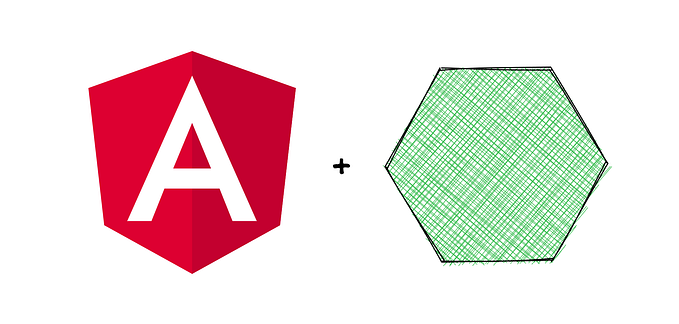10 Angular Dos & Don’ts
Improve the development, modularity, and performance of your Angular apps.
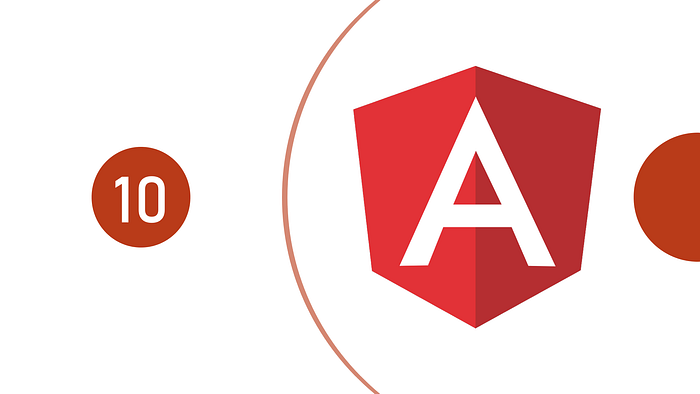
#1 Separation of Concerns
The beauty of Angular architecture lies in splitting the codebase.
- Components — reusable building blocks that contain business parts and create UIs.
- Directives — classes that add new or modify the existing behavior of the UI elements in the template.
- Pipes — functions used in a template that take in data as an input and transform it into an output.
- Services — classes that handle the business logic and talk to APIs.
- Modules — classes that group Components, Directives, Pipes, and Services into features.
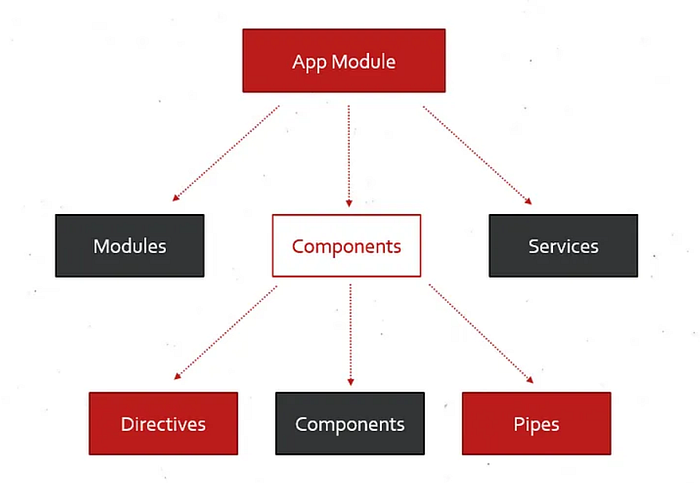
This separation respects a single-responsibility principle and results in a cleaner codebase.
Avoid importing all the components, directives, and services in your main module.
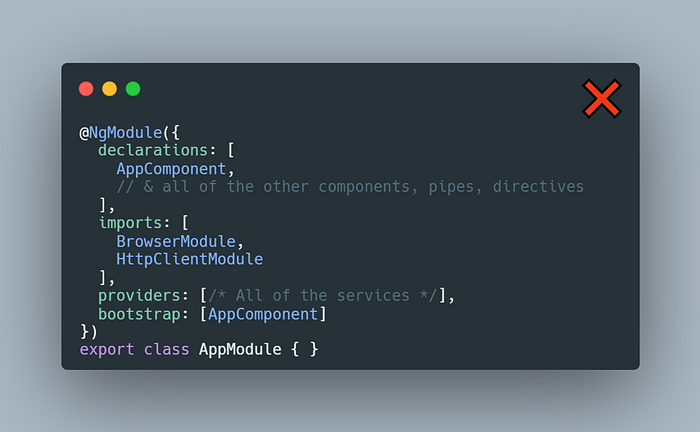
Instead, split functionalities per module (feature modules). As you import only the parts related to your feature within it, the modules will remain smaller and code cleaner.
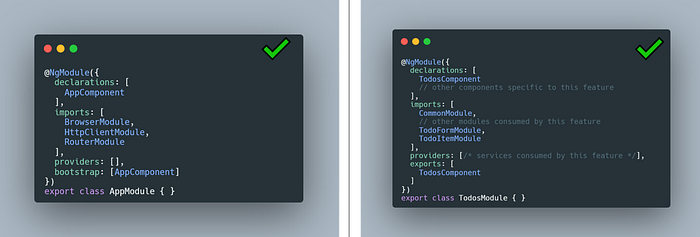
This can be used in conjunction with the Router to enable Lazy Loading.
const routes: Routes = [
{
path: 'home',
component: HomeComponent,
},
{
path: 'todos',
// lazy loaded route
loadChildren: () => import('./Todos.module').then(m => m.TodosModule),
},
]In this example, The Todos module and its dependencies will be loaded only after landing on the specified route. The fewer dependencies used in the main module, the faster your app will load.
#2 Use Angular CLI
Angular CLI is a built-in tool that speeds up app development by allowing you to generate application parts and wire up dependencies automatically.
To kick things off, you can generate a new Angular application using:
ng new my-appInstead of manually creating files in your codebase, use the CLI:
▶ Generate a new component:
ng g c component-name▶ Generate a service:
ng g s service-name▶ Generate a pipe:
ng g p pipe-name▶ Preview what will be generated
ng g c modules/components/blog --dry-run
CREATE src/app/modules/components/blog/blog.component.html (19 bytes)
CREATE src/app/modules/components/blog/blog.component.spec.ts (545 bytes)
CREATE src/app/modules/components/blog/blog.component.ts (195 bytes)
CREATE src/app/modules/components/blog/blog.component.scss (0 bytes)
UPDATE src/app/app.module.ts (595 bytes)
NOTE: The "--dry-run" option means no changes were made.And similar.
The CLI also allows you to install packages that belong to the Angular standard library For example:
ng add @angular/material#3 Use Framework Tools
Instead of reinventing the wheel using native JavaScript APIs like Document, Fetch, or performing manual form validations. use the tools that are built into the framework.
Angular comes with a host of features for development.
- Navigation between routes (Router)
- API communications (HTTP Client)
- State management (Rx.js, Signals)
- DOM Manipulation (ElementRef)
- Creating forms (Reactive and template-driven)
- Intercepting and caching API calls (HTTP Client Interceptor)
- Restrict access to routes (Route Guard)
- Testing framework (Jasmine)
- Conditionally display UI elements (ngIf, ngSwitch, ngFor), etc.
#4 Pipes
Let’s say you need to transform a value in a template. Naturally, you’d create a function in the component TypeScript file and do something like:
<h2>{{ doSomething(someFormValue) }}</h2>This will work, but it is very bad for performance as the function will be called repeatedly on every re-render.
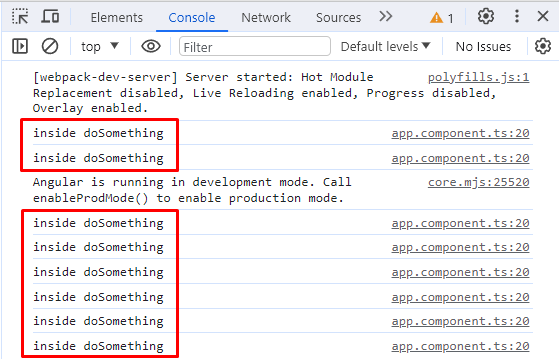
In these scenarios, you should use Pipes. Upon generating a pipe,
ng g pipe doSomething@Pipe({
name: 'doSomething'
})
export class DoSomethingPipe implements PipeTransform {
transform(value: unknown, ...args: unknown[]): unknown {
// perform some transformations
console.log('inside doSomething Pipe');
return 'transformed-data'
}
}Apply it in the template using the pipe ( | ) symbol.
<h2>{{ someFormValue | doSomething }}</h2>Now you have the exact same functionality built via Pipe. The difference between the two approaches is immediately evident.
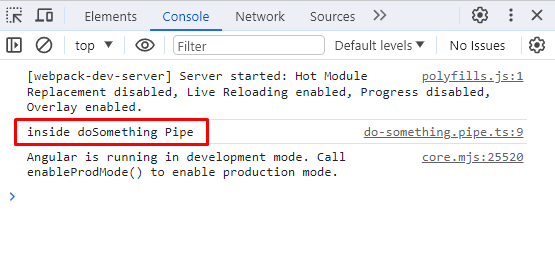
#5 Make use of Dependency Injection
One of the most powerful features of Angular is a Dependency Injection. Instead of a component creating its own dependencies, e.g:
// creating instances manually
private service = new PostsService();, they can be provided from the outside and injected via a constructor (or inject() function):
constructor(private readonly service: PostsService) { }The underlying dependencies are registered in the modules as providers:
@NgModule({
declarations: [
AppComponent,
],
imports: [
BrowserModule,
HttpClientModule
],
providers: [PostsService], // <-- registering PostsService dependency
bootstrap: [AppComponent]
})
export class AppModule { }Services can also have a flag providedIn set that shows where it is provided. In this case, the service is provided in the root module by default, which eliminates the need for the service to appear in the providers array.
@Injectable({
providedIn: 'root'
})
export class PostsService With Dependency Injection in place, the Angular code is:
- Reusable
- Modular
- Easier to test (as you can just swap the real dependency with the mocked one)
This is just the beginning of DI in Angular. If you’d like to learn more, I advise you to look up these topics:
- Injectors
- Injection Tokens
- Overriding dependencies (
useClass,useValue,useFactory) - Components relationship (
@self,@skipSelf,@host,@optional)
#6 Share data between non-related components
The common practice is to use the Input and Output directives when sharing data between components. This is great when you have a parent-to-child or child-to-parent component relationship.
However, if you need to send data to a grandchild or grand-grandchild component or a sibling component, then it’s going to be a lot of work. Not to mention if you have to update the data, you’ll have to make changes in all places.
To avoid this you can make use of Rx.js Behavior Subject to build a centralized place to store data and for consumers to retrieve it.
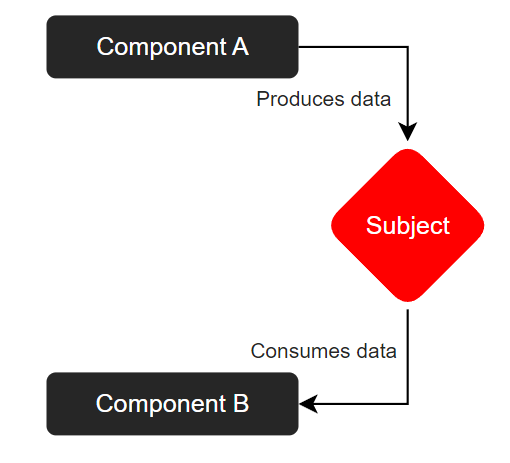
It all works on the Publisher-Subscriber pattern. One component pushes the data to the Subject, while the other consumes by subscribing to the Observable.
Create a State Service
To see this in action create a new service and a Behavior Subject with a default count (1). It’s a good practice to make this subject private to prevent it from being modified from the outside.
@Injectable({
providedIn: 'root'
})
export class SharedDataService {
private readonly currentCount$ = new BehaviorSubject<number>(1);
public setCount(count: number): void {
const currentValue = this.currentCount$.value;
this.currentCount$.next(currentValue + count);
}
public getCount() {
return this.currentCount$.asObservable();
}
}Using setCount() an outside component can change the current count.
Using getCount() an outside component can retrieve the current count as Observable to subscribe to.
Producer Component
Inject the service and create two buttons that increase or decrease the count on click — basically call the same method with a different value.
constructor(private readonly service: SharedDataService) { }
increaseCount() {
this.service.setCount(1);
}
decreaseCount() {
this.service.setCount(-1);
}<button (click)="increaseCount()">Count +1</button>
<button (click)="decreaseCount()">Count -1</button>Consumer Component
Inject the same service, only this time call the getCount() method.
constructor(private readonly service: SharedDataService) { }
ngOnInit() {
this.service.getCount()
.subscribe(console.log)
}Now the two components can share data without being connected to each other.
#7 Use Rx.js Operators
Don’t run from Rx.js. Make a good use of it.
It’s a powerful tool with many adversities that work well with Angular.
Map data
You can map the response to your needs in the Observable pipe directly:
titles!: string[];
constructor(private readonly service: PostsService) { }
ngOnInit() {
this.service.getAllPosts()
.pipe(
map((data: Posts[]) => data.map(post => post.title))
)
.subscribe(data => this.titles = data)
}<div *ngFor="let title of titles">
{{ title }}
</div>Filter data
Additionally, you can filter content based on criteria.
ngOnInit() {
this.service.getAllPosts()
.pipe(
map((data: Posts[]) => data.map(post => post.title)),
filter((data: string[]) => data.length > 0)
)
.subscribe(data => this.titles = data)
}Share data between subscribers
Sometimes you may want to consume the same Observable in multiple places. The Observables are designed to be cold in nature, meaning the Observable is recreated for each new subscriber.
In this example, the Observable is working with an API and each new subscriber will call the same API for its purposes.
const postsData$ = this.service.getAllPosts();
const firstSubscriber$ = postsData$;
const secondSubscriber$ = postsData$;
firstSubscriber$.subscribe(console.log);
secondSubscriber$.subscribe(console.log);
To fix this, convert this cold Observable into a hot one using the share() operator.
const postsData$ = this.service.getAllPosts()
.pipe(
share()
)
const firstSubscriber$ = postsData$;
const secondSubscriber$ = postsData$;
firstSubscriber$.subscribe(console.log);
secondSubscriber$.subscribe(console.log);Now multiple subscribers will share the same Observable.

Merge Observables
In order to consume the Observable data you need to subscribe to it. However, if you have one API that depends on another, does that mean that you need to subscribe twice? Let’s find out.
getCurrentUser(): Observable<User> {
const user = {
id: 1,
name: 'Mirza',
profession: 'DEV'
};
return of(user);
}This function will return a sample user. To combine it with the Posts service, a naive way would be to do something like this:
myPost?: Posts;
private getUserPost() {
this.getCurrentUser()
.subscribe((user: User) => {
this.service.getAllPosts()
.subscribe((posts: Posts[]) => {
this.myPost = posts.find(post => post.userId === user.id);
})
})
}This will work, but it is a horribly bad practice.
In situations like these, you want to merge the two streams into one using operators like mergeMap, switchMap, and similar.
private getUserPost() {
this.getCurrentUser()
.pipe(
mergeMap((user) => this.service.getAllPosts()
.pipe(
map((posts: Posts[]) => posts.find(post => post.userId === user.id))
))
)
.subscribe((post?: Posts) => {
this.myPost = post;
})
}There are many more Rx.js operators with just as interesting use cases. I encourage you to go through the Rx.js docs and learn more.
#8 Unsubscribe from Observables
An important detail that many new Angular developers miss is to unsubscribe from the Observables.
export class AppComponent implements OnInit {
postsData!: Posts[];
constructor(private readonly service: PostsService) { }
ngOnInit() {
this.service.getAllPosts()
.subscribe(data => this.postsData = data)
}
}Even though Angular APIs work hand in hand with Rx.js, Rx.js Observables do not know when the Angular component is no longer used. When the subscription remains active, it leads to memory leaks and potentially unexpected behavior or errors when trying to update the component.
To resolve the issue you need to manually unsubscribe from all the Observables after you’ve stopped using the component. This can be done using a variety of take operators.
export class AppComponent implements OnInit, OnDestroy {
postsData!: Posts[];
// Creating subject that will be used to unsubscribe
private unsubscribe$ = new Subject<void>();
constructor(private readonly service: PostsService) { }
ngOnInit() {
this.service.getAllPosts()
.pipe(
// Observable will remain active until this subject completes
takeUntil(this.unsubscribe$)
)
.subscribe(data => this.postsData = data)
}
ngOnDestroy() {
this.unsubscribe$.next();
// Subject will complete when the component is destroyed
this.unsubscribe$.complete();
}
}#9 Async pipe
Async pipe is built into Angular that allows us to subscribe to Observables or resolve Promise directly in the template.
Without Async pipe
You need to subscribe within a component, assign the subscription data to a property, and manually unsubscribe.
export class AppComponent implements OnInit, OnDestroy {
postsData!: Posts[];
private unsubscribe$ = new Subject<void>();
constructor(private readonly service: PostsService) { }
ngOnInit() {
this.service.getAllPosts()
.pipe(
takeUntil(this.unsubscribe$)
)
.subscribe(data => this.postsData = data)
}
ngOnDestroy() {
this.unsubscribe$.next();
this.unsubscribe$.complete();
}
}<div *ngFor="let post of postsData">
{{ post.title }}
</div>With Async pipe
You can assign Observable directly to the property and subscribe within the template. The Async pipe also automatically disposes (unsubscribes) the Observable when the component is no longer been used.
export class AppComponent implements OnInit {
postsData$!: Observable<Posts[]>;
constructor(private readonly service: PostsService) { }
ngOnInit() {
this.postsData$ = this.service.getAllPosts();
}
}<div *ngFor="let post of postsData$ | async">
{{ post.title }}
</div>#10 OnPush Change Detection
When something changes in one component, Angular traverses the entire components tree to check if any of the components have changed. This is a default change-detection behavior and is super inefficient in projects with many components.
To combat this, the Angular team introduced OnPush change detection that rerenders a component only in these cases:
- When new Input (props) is received by the component
- When a new event is triggered in the component (or child components)
- When an Observable you’re component is subscribed to receives a new value
@Component({
selector: 'app-root',
templateUrl: './app.component.html',
styleUrls: ['./app.component.scss'],
changeDetection: ChangeDetectionStrategy.OnPush // <-- applying it
})
export class AppComponent implements OnInit {
@Input() title: string = 'Default';
updateTitle() {
this.title = 'Updated';
}
}When you call the updateTitle() method on button click, Angular will mark this component and all its parent components as “dirty.”
This does not affect child components. The child components are only marked as dirty if they receive a new value through an input property.
The OnPush change detection is more efficient because it reduces the number of checks, which leads to better performance and responsiveness.
This was just a small slice of everything that Angular has to offer. To learn more, be sure to check out my other articles.
Bye for now 👋








